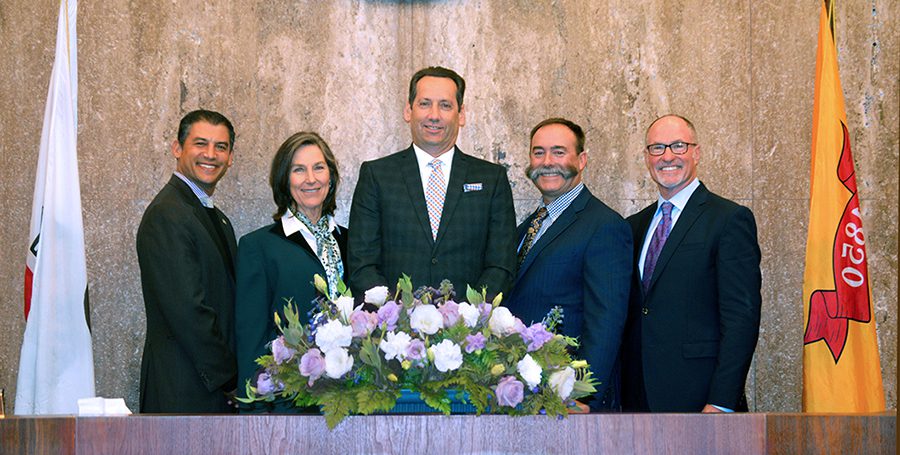By Giana Magnoli
Noozhawk Managing Editor
Santa Barbara County is looking at a surplus of $3.5 million for this fiscal year, but “the potential for a funding gap continues to grow” over the next five years as costs keep increasing for employee salaries, benefits and pensions.
That assessment was offered to the county Board of Supervisors Feb. 26 by Jeff Frapwell of the County Executive Office.
Salaries are predicted to increase 3 percent per year for the next five years, pension costs are expected to increase 5 percent per year, and health insurance costs will go up 5 percent per year, according to county staff.
Out of a billion-dollar budget, the county’s salary and benefit costs this year are about $613 million; retirement costs are about $144 million and expected to increase $30 million over the next five years.
That increase will be offset a little by cost-sharing with employees, which started last year and is forecast to save $8.5 million a year by 2025.
Health insurance costs are budgeted at more than $43 million for the current year, and are forecast to increase $9 million over the next five years, according to county staff.
The countywide backlog of deferred maintenance projects is estimated at $438 million for the Public Works, Community Services and General Services departments, according to the county.
The supervisors will make spending decisions later this year, starting with April budget workshops, and the Feb. 26 presentation was a preview of the county’s fiscal future.
In addition to ongoing costs, the Board of Supervisors was presented with a long list of big-ticket capital projects and one-time expenses to “keep on the radar screen,” as Frapwell said, including:
– Major renovations at the Main Jail at 4436 Calle Real, estimated in November to cost $25 million, plus $1.4 million for jail security and CCTV system upgrades.
– Public safety communications system equipment replacement ($50 million) plus radio tower improvements (over $2 million).
– Roof replacement for the Anacapa Santa Barbara Superior Courthouse ($3.1 million).
– New Probation Department headquarters ($19.5 million).
– Expanding the Emergency Operations Center, which was built in 2011 ($5 million).
– Replacing the Calle Real water system ($2 million).
– Cachuma Lake Recreation Area upgrades ($12 million).
– Replacing Sheriff’s Department equipment, including in-car video and computer systems ($2.4 million).
– Solar projects ($4.5 million).
– Technological upgrades, including $500,000 to transition to a cloud-based countywide website.
There is also a $10.4 million item for the anticipated local share of FEMA Hazard Mitigation Grant Program funding, since the county Public Works Department has applied for $41.8 million toward seven projects related to damages from the Jan. 9, 2018, Montecito debris flows.
The voter-approved cannabis tax is generating its first revenues this year, and is expected to bring in $5.5 million for the current fiscal year, which ends June 30, and primarily funds enforcement, Frapwell said.
Deputy County Executive Officer Dennis Bozanich said the county has 23 staff positions dedicated to cannabis-related enforcement and compliance, including in permits and licensing (which is funded through fees), county counsel, law enforcement and planning staff. All the positions are filled, he said.
While planning staff work with operators going through the lengthy permitting and licensing process, compliance teams have been conducting raids of illegal marijuana operations, including grows, over the past few months.
After the budget preview, Santa Barbara County staff presented the option of asking voters for a sales-tax increase in 2020, but there are mixed feelings on the Board of Supervisors, which initially rejected the idea.
The current 7.75-percent sales-tax rate for unincorporated areas brings in $7.27 million annually, and staff presented options for a 2020 ballot measure asking voters to increase the rate.
Supervisors Peter Adam and Steve Lavagnino were against the idea, while other board members were supportive of a poll to query voters’ opinions.
It would take four of five board members to put a sales-tax increase measure on the ballot.
Instead, the supervisors asked county staff to look into a measure to increase the Flood Control Benefit Assessment for the South Coast, given the large amount of projects and costs related to storms and debris basins.
The county could go for a general tax, which needs majority voter approval, or a specific tax, which needs two-thirds voter approval to pass.
The tax could be used to fund some of the big-ticket capital projects, such as the public safety communications equipment, infrastructure improvements, or ongoing services such as libraries, mental health and public health programs, Bozanich said.
Supervisor Das Williams said there will probably never be enough money to tackle deferred maintenance and infrastructure costs unless the county goes for a tax. Supervisor Gregg Hart called the poll a good investment, to see whether voters supported increasing sales tax to fund governmental services and infrastructure.
Lavagnino said he “stuck my neck out a couple of times” supporting the cannabis tax and transient-occupancy tax increase. He “got burned” with TOT since the board then voted to eliminate short-term rentals, which would have provided about the same amount of revenues as the increased rate, he said.
Adam, who has long advocated for more funding dedicated to infrastructure and deferred maintenance, said he could not support putting a sales-tax increase on the ballot.
The county keeps spending money on things other than maintenance, and does not tackle the backlog in a meaningful way, he said.
“I’m not going to support this; we’re just enabling ourselves to continue to kick the can down the road and not solve the problem while we tell everybody we’re really solving the problem,” he said.
Adam and Hart are going to talk “offline” about other options, including potential revenue-increasing measures, and report back to the board, they said.
“We can’t say no to everything,” Adam said. “We continually say no to everything and expect more money to come out of a tree,” he said.
Noozhawk managing editor Giana Magnoli can be reached at gmagnoli@noozhawk.com.





